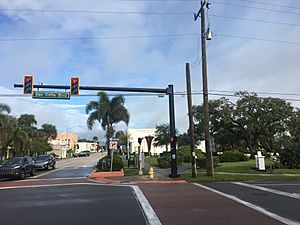Eau Gallie, Florida facts for kids
Quick facts for kids
Eau Gallie, Florida
|
|
|---|---|
| Country | |
| State | |
| County | |
| City | |
| Settled | 1859 |
| First settler | John Caroll Houston, IV |
| Incorporated | 1860 |
| Consolidated with Melbourne | 1969 |
| Founded by | William Henry Gleason |
| Time zone | UTC-5:00 (Eastern) |
| • Summer (DST) | UTC-4:00 (Eastern) |
Eau Gallie (pronounced "oh GAL-ee") is a neighborhood in the city of Melbourne, Florida. It is located on the northern side of Melbourne. For many years, Eau Gallie was its own independent city in Brevard County. It was an independent city from 1860 until 1969.
In 1969, people living in Eau Gallie and Melbourne voted to join their city governments. They then voted to call the combined city "Melbourne." Even though they merged, the name and identity of Eau Gallie are still used today. For example, the Eau Gallie Arts District Main Street program uses the name.
Contents
History of Eau Gallie
A post office opened in Eau Gallie in 1871. It served the community until 1970. The Kentucky Military Institute, a military school, spent its winters in Eau Gallie. This happened every year from 1907 to 1921.
People often say that Eau Gallie means "rocky water." This is because coquina rocks, which are made of shells, were found in the area. The word eau means "water" in French. However, gallie is not a French word. It might come from the French word galet, which means "pebble."
Some people thought the name came from the Chippewa language. But Chippewa speakers lived much farther north than Florida.
What Eau Gallie is Like Today
Eau Gallie has many old, historic buildings. It also has beautiful live oak trees and native plants. The area is located right on the Indian River Lagoon.
Important places in Eau Gallie include:
- The Eau Gallie Civic Center
- The Public Library and Pier
- Pineapple Park, which has a lighted gazebo under old live oaks
- The Foosaner Art Museum/FIT
- The Renee Foosaner Education Center
Eau Gallie is also home to the Eau Gallie Arts District Main Street program (EGAD). This is a recognized organization that helps improve downtown areas. It has won awards for its work.
This area has many art galleries and long-standing businesses. New businesses have also opened here. The Eau Gallie Arts District has an Outdoor Art Museum. This museum features over 30 murals, a mosaic, and sculptures. The Historic Rossetter House Museum and Gardens is also in Eau Gallie. It is on the National Register of Historic Places, which means it's a very important historical site. You can take tours of the house, rent space for events, and attend special events there.
Historic Places in Eau Gallie
Eau Gallie has a special historic area. It includes several important museums and houses. These are:
- The Advent Christian Church
- The Foosaner Art Museum
- The Ginter Building
- The Historic Rossetter House Museum
- The James Wadsworth Rossetter House (also on the National Register of Historic Places)
- The Karrick Building
- The Roesch House
- The Winchester Symphony House
There is an area of about 14 acres with 31 houses. People are asking for this area to be officially recognized as a Historic District. The first permanent European-American settler, John Carroll Houston, arrived in 1859.
Namesakes in the Community
Eau Gallie Square is a public green space in the Eau Gallie Arts District. It has live oak trees and a band shell. This square is a central spot for many community events. It is also where the Rocky Water Brew Fest takes place.
Famous People from Eau Gallie
- Thomas Barbour: He was a herpetologist, someone who studies reptiles and amphibians. In 1898, when he was 14, he lived in Eau Gallie with his grandmother.
- Zora Neale Hurston: A famous author. She lived in a small house on Guava Avenue and Fifth Street two different times. First in 1929 and again in 1951.
- Mark Boswell: A film director. He lived in a house at the corner of Pineapple Avenue and Montreal Boulevard from 1990 to 1992.


